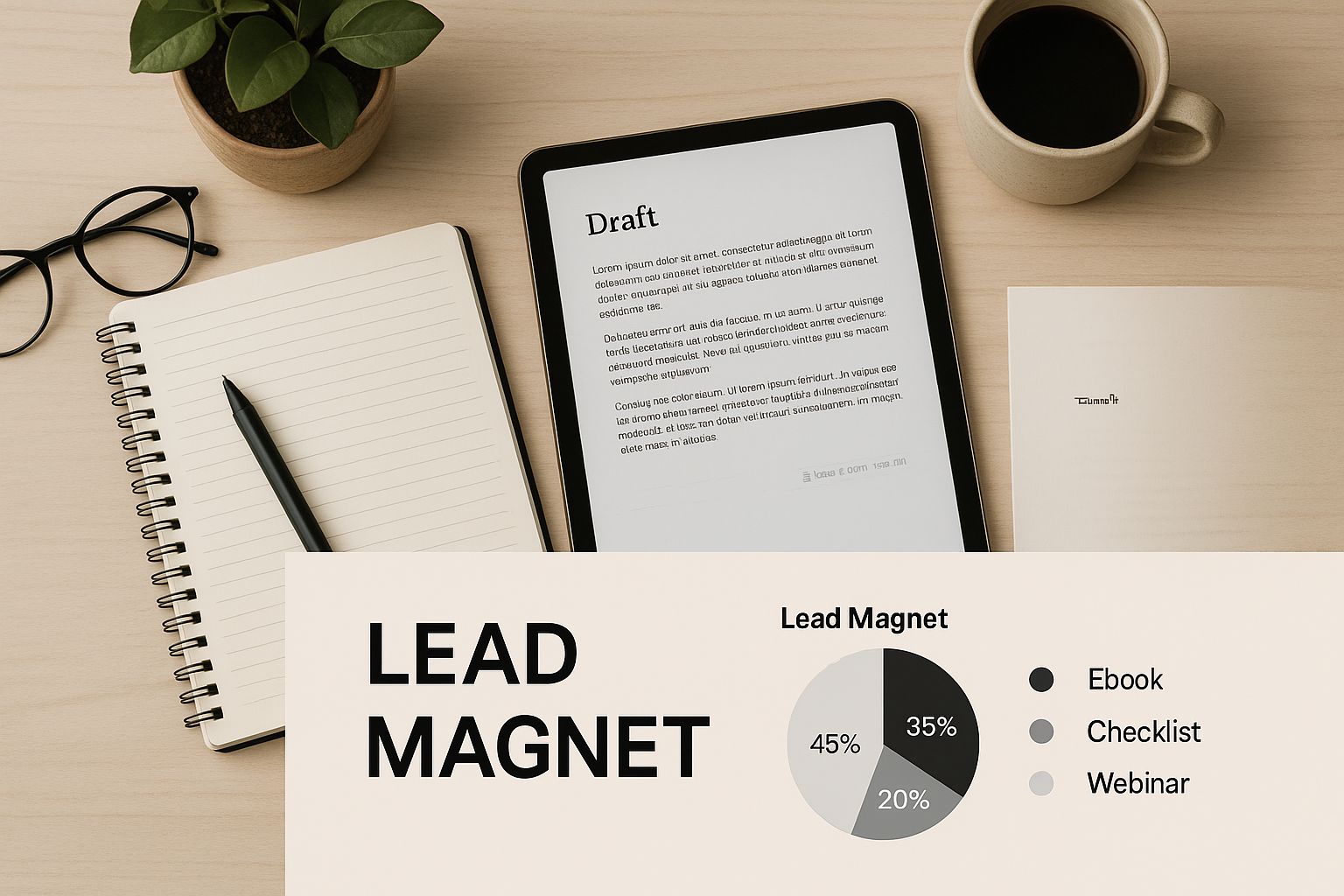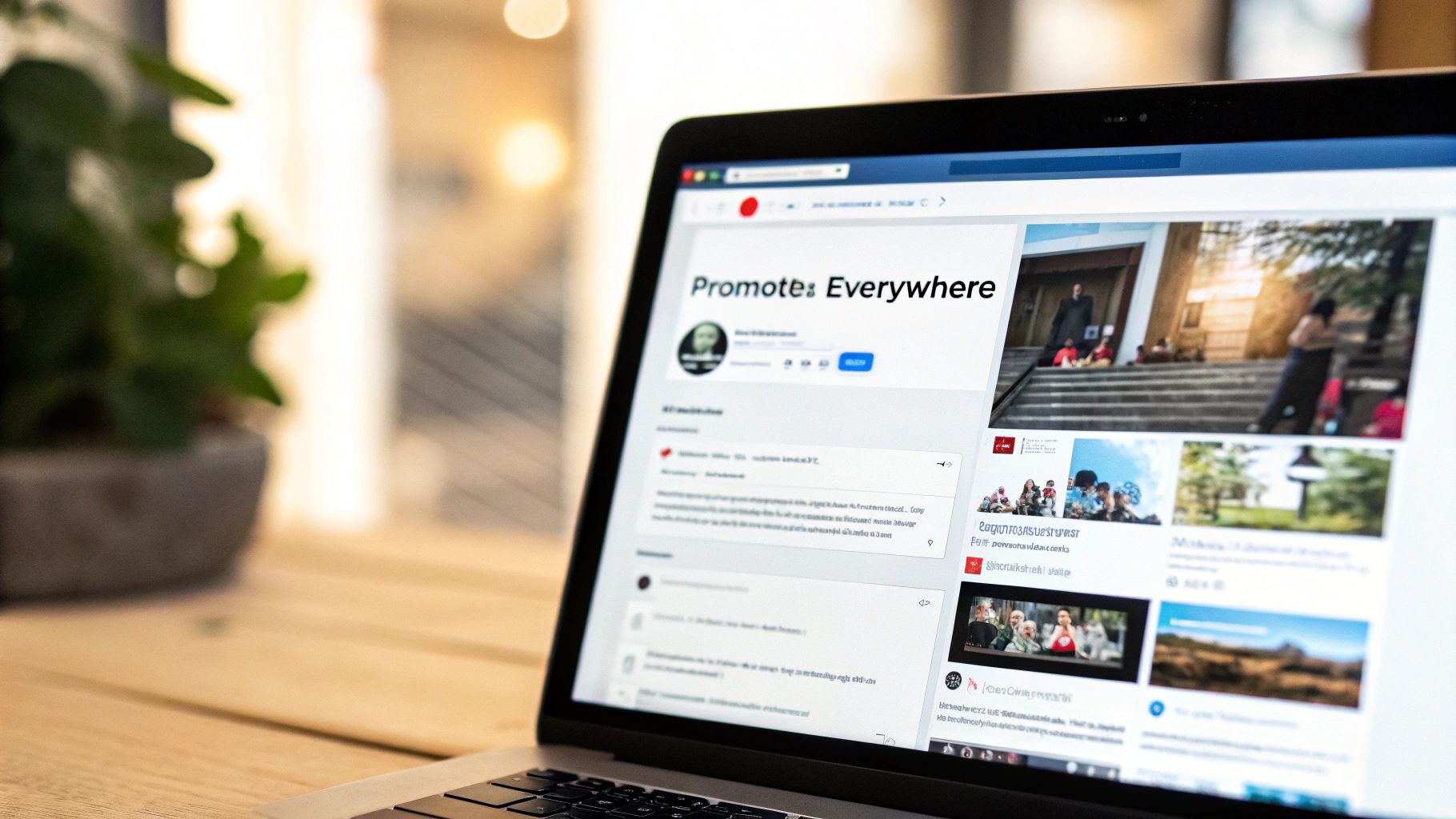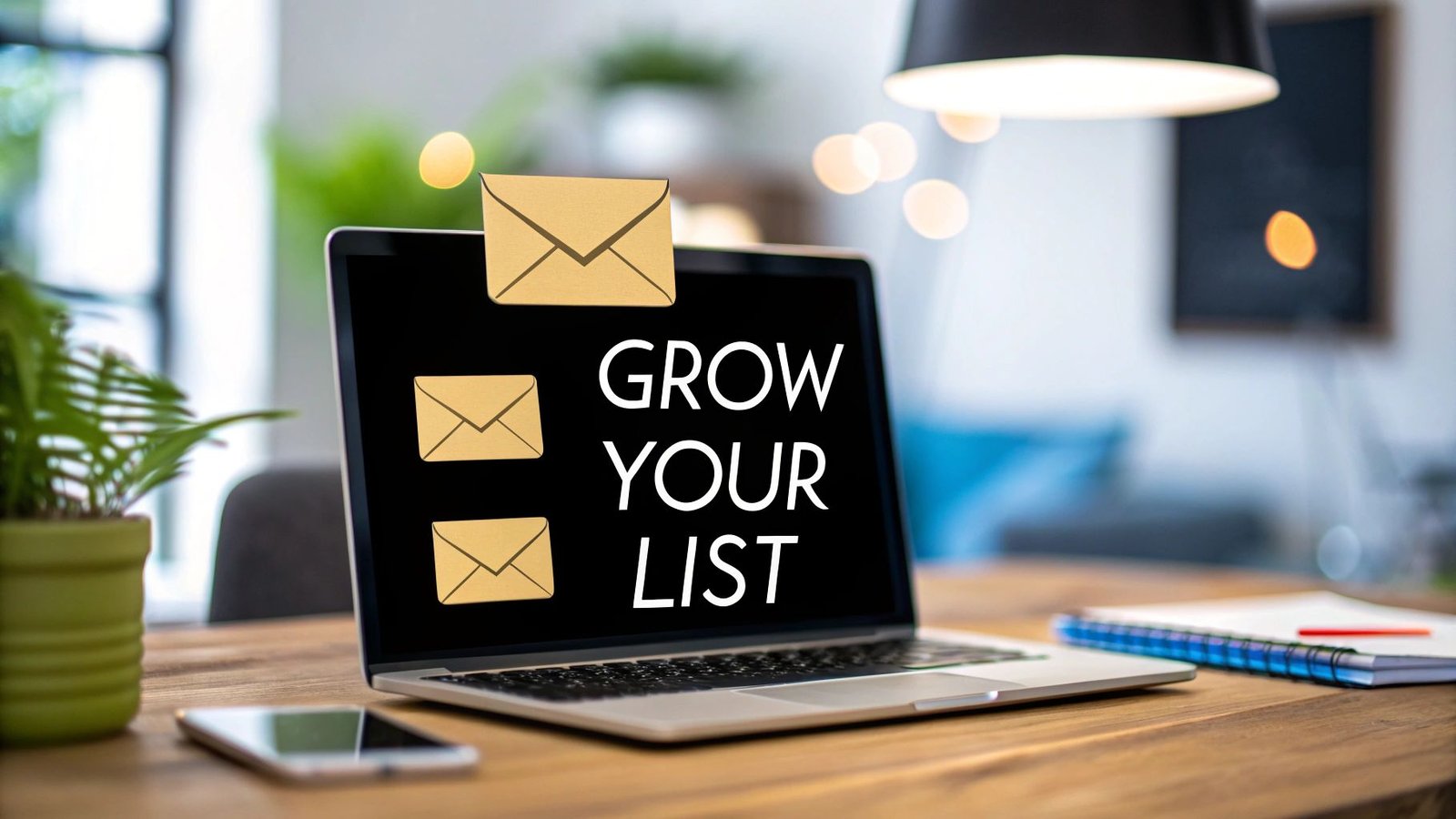The whole game of building a mailing list boils down to a simple trade: you offer something genuinely valuable, and in return, someone gives you their email address. This "something" could be a handy checklist, an exclusive discount code, or a deep-dive guide they can't get anywhere else.
At its core, you're creating a direct line to people who are actually interested in what you have to say.
Why an Email List Is Your Best Business Asset

Think about it. We live in a world where social media algorithms are constantly changing, and what worked yesterday might not work tomorrow. Your email list? That's one of the only marketing channels you actually own.
Unlike your social media following, which can vanish overnight thanks to a platform update you have no control over, an email list gives you a stable, direct connection to your audience. When you hit "send," your message lands in a personal inbox—a much less chaotic and crowded space than a typical social media feed. That direct access is pure gold for building real relationships.
The Foundation of Sustainable Growth
I like to think of a mailing list as the predictable growth engine for a business. Every single person who subscribes has raised their hand and given you explicit permission to contact them. This is the bedrock of effective, permission-based marketing.
A healthy, well-managed list brings some serious advantages to the table:
- Direct Traffic on Demand: Got a new product launching or a fresh blog post? An email to your list can send a wave of engaged traffic your way, right when you need it.
- Deeper Customer Loyalty: Consistent, valuable communication keeps your brand at the front of people's minds. You're not just a company; you're building a community.
- Predictable Revenue: When you understand how your list engages and converts, you can forecast sales from promotions with a surprising degree of accuracy.
This stability is exactly why so many seasoned entrepreneurs and marketers treat their email list as their most prized asset. It's a long-term investment that only grows more valuable over time.
Here's the bottom line: it's all about control. If you rely only on social media, you're essentially building your business on rented land. An email list is property you own outright, giving you the power to talk to your audience whenever and however you want.
The data backs this up, too. A staggering 82% of marketers across the globe depend on email marketing. The industry itself was valued at $8.5 billion in 2021 and is on track to hit nearly $18 billion by 2027.
It’s a powerful signal that even with all the new channels popping up, email is still a heavyweight champion in business communication. You can discover more insights about email marketing statistics on dyspatch.io to see the full picture.
Finding Your First 100 Engaged Subscribers
Getting those first subscribers can feel like climbing a mountain. Forget about sketchy shortcuts like buying lists; the real goal is to find people who actually want to hear what you have to say. A solid list isn't built on raw numbers—it’s built on genuine engagement.
Think of your first 100 subscribers as your founding members. These are the people who will give you priceless early feedback, share your work, and ultimately become your biggest fans. If you focus on quality from the very beginning, the numbers will take care of themselves.
Start With the People You Already Know
Before you even think about running an ad, tap into the network you already have. This is the absolute lowest-hanging fruit, and it's a fantastic way to get some initial momentum without coming across as pushy. Your personal and professional circles are full of people who already know and trust you.
I always recommend starting with these groups:
- LinkedIn Connections: These are professionals who already see you as an expert. A simple post announcing your new project or newsletter can be surprisingly effective.
- Past Colleagues or Clients: You’ve already built a relationship here. A quick, personal email letting them know what you’re up to and why it might be valuable for them is a great touch.
- Friends and Family: Even if they aren't your target audience, they can be your first cheerleaders and help spread the word to their own contacts.
The secret is to be authentic. Don't send a generic blast to everyone. Explain the value you're offering—are you sharing hard-won industry insights, step-by-step tutorials, or a unique perspective they won't find elsewhere? Frame it as a personal invitation, not a marketing pitch.
Create a Simple, High-Value Offer
You have to give people a solid reason to trust you with their email address. This is where a lead magnet comes in, but it doesn't need to be a 50-page ebook or a complicated video series. For your first 100 subscribers, simple is almost always better.
Think about a "quick win" you can give your audience. What’s a nagging problem they deal with that you can solve for them in a simple, easy-to-digest format?
A great lead magnet solves a specific problem, fast. I’ve found that a one-page checklist that helps someone complete a task is often way more valuable than a massive ebook they'll download and never actually read.
Here are a few ideas for simple lead magnets that work wonders:
- A One-Page Checklist: Something like, "The 10-Point SEO Audit Checklist for Your Website."
- A Curated Resource Guide: For instance, "My Top 5 Free Tools for Managing Projects."
- A Simple Template: Think a pre-built spreadsheet or a customizable content calendar for social media.
The idea is to offer something that delivers immediate value and showcases your expertise. This simple exchange is the first step in building trust and laying the groundwork for a strong relationship with your new subscriber. It’s a core part of learning how to get a mailing list that grows the right way.
Optimize Your Digital Real Estate
Make it dead simple for people to subscribe wherever they interact with you online. Don't make them hunt for a sign-up form. Instead, weave it naturally into all your online properties.
Put clear calls-to-action in these high-traffic spots:
- Your Website Homepage: A simple sign-up bar at the top or a dedicated section right at the top of the page works perfectly.
- Your Social Media Bios: Your profiles on Instagram, X (formerly Twitter), and LinkedIn should all have a direct link to your newsletter landing page. It's prime real estate.
- Your Email Signature: This is one of my favorite tricks. Just add a simple line like, "P.S. Get my weekly marketing tips right here" with a link to your sign-up page.
Every place someone sees your name is an opportunity. When you make the subscription process seamless and obvious, you eliminate friction and make it much more likely that a casual browser will become a core member of your community.
Choosing the Right Tools for List Building
Once you start getting subscribers, you need a solid system to manage them. This is where an Email Service Provider (ESP) comes in. Think of it as your command center—it’s the software that handles everything from sending your newsletters to tracking how well your campaigns are performing.
Picking the right ESP is more than just finding the cheapest plan. It’s about choosing a partner that can grow with you. A tool that seems perfect today could become a real headache six months down the line if it can't keep up with your needs. It's all about finding that sweet spot between what you need now and where you plan to be.
What to Look for When You’re Starting Out
When you're just getting your feet wet, your needs are pretty simple. You don't need a massive, complex system with a dozen advanced features you'll never use. Instead, your focus should be on platforms that have a generous free or low-cost starting point with all the essentials.
Here’s what I’d prioritize on an initial checklist:
- Ease of Use: A clean, intuitive interface is a must. You want to spend your time writing great content, not wrestling with a clunky editor.
- Reliable Deliverability: An amazing email is useless if it ends up in the spam folder. Look for providers known for getting emails delivered straight to the inbox.
- Simple Sign-Up Forms: Your ESP should make it dead simple to create and embed good-looking sign-up forms on your website or landing pages.
Many of the best ESPs offer free plans that cover up to 500 or 1,000 subscribers. That’s more than enough runway to get your first campaigns launched without spending a dime.
Your email tool will manage the entire subscriber journey, which often starts with a compelling lead magnet you create.

As you can see, the path from a curious prospect to a loyal subscriber begins with that valuable offer. Your ESP is what helps you nurture that relationship from there.
Planning for Future Growth
As your mailing list gets bigger, your needs will definitely evolve. The simple tool that was perfect for your first newsletter won't cut it when you need to send highly targeted messages to different groups of people. This is where more advanced features become absolutely essential.
Don't just pick a tool for where you are today; pick one for where you want to be in a year. Migrating an entire email list is a massive pain you want to avoid if you can. It’s far better to choose a platform with a clear path to scale.
As you start comparing platforms with an eye on the long term, here are the features that really matter:
- Automation Capabilities: This is a total game-changer. Being able to set up automated "welcome" sequences for new subscribers or trigger follow-up emails based on what a user does saves an incredible amount of time and keeps your audience engaged.
- Audience Segmentation: As your list grows, you’ll stop talking to everyone the same way. Segmentation lets you group subscribers by their interests, what they've bought, or how they interact with your emails, so you can send them content they actually care about.
- CRM Integrations: Your ESP needs to work well with the other tools you use. For a lot of businesses, connecting your email list with a Customer Relationship Management (CRM) system is critical for having a complete picture of your contacts. If you're new to the concept, you can learn more by exploring the customer relationship management basics to see how these systems fit together.
- Advanced Analytics: Look for reporting that’s clear and gives you real insights, not just vanity metrics like open rates. You'll want to spot trends over time and understand which topics and offers truly connect with your subscribers.
Comparing Popular Email Service Providers
To help you get a clearer picture, I've put together a quick comparison of a few popular platforms. This feature breakdown should help you decide which type of tool is the best fit for your current needs and future growth plans.
| Feature | Best for Beginners (e.g., MailerLite) | Best for Creators (e.g., ConvertKit) | Best for All-in-One (e.g., HubSpot) |
|---|---|---|---|
| User Interface | Clean, simple, and very easy to navigate. Drag-and-drop editor. | Designed for content creators, with a focus on simplicity and speed. | Comprehensive but can have a steeper learning curve due to all the features. |
| Free Plan | Generous free plan for up to 1,000 subscribers with core features. | Free for up to 1,000 subscribers, but automation is a paid feature. | Robust free tools, including CRM, but email features are limited. |
| Automation | Good visual automation builder included, even on lower-tier plans. | Powerful and flexible visual automations built for creator funnels. | Enterprise-level workflows that tie into sales, marketing, and service. |
| Segmentation | Solid tagging and segmenting options for targeted campaigns. | Subscriber-centric tagging system is core to the platform. | Extremely advanced segmentation based on CRM data and user behavior. |
| Best For | Small businesses, bloggers, and anyone needing a powerful, low-cost start. | Bloggers, YouTubers, podcasters, and course creators focused on audience. | Businesses needing an integrated sales, marketing, and service platform. |
Ultimately, choosing the right ESP is a strategic move. By thinking ahead about where you're headed, you can pick a tool that not only helps you get started but also grows into one of your most powerful business assets.
Creating Opt-In Offers People Actually Want
An email address is a personal thing. Let’s be real—nobody gives it away for free anymore. If you want to grow a high-quality mailing list, you need to offer a fair trade. This is where your opt-in offer, or "lead magnet," comes in. It has to be something that solves a real, nagging problem for your ideal customer.
The most effective offers aren't always the biggest. A simple, one-page checklist that solves an immediate headache is often way more powerful than a 50-page ebook that feels like homework. Think about what keeps your audience up at night and create a simple solution they can use right now.
Pinpoint Their Biggest Pain Points
Before you even think about creating your offer, you have to get inside your customer's head. What are their daily frustrations? What goals are they desperately trying to hit? The answers to these questions are the foundation of an offer that actually converts.
This is exactly why having solid buyer personas is a non-negotiable part of the process. When you truly understand your audience, you can stop creating generic offers and build something that feels like it was made just for them. If you haven't done this yet, pausing to create buyer personas for your business is the single best thing you can do for your marketing.
Once you’ve nailed down their core problems, you can design an offer that provides a direct, satisfying solution.
The best lead magnets act as a bridge. They connect a visitor’s current problem to the broader solution your product or service provides, giving them an immediate win while showcasing your expertise.
For example, if you sell project management software, a "Kickstart Your Next Project" template is a fantastic lead magnet. It's infinitely more compelling than a generic "Sign up for our newsletter" pop-up.
Ideas for Irresistible Opt-In Offers
Different formats work for different audiences, so think about what would be genuinely useful for your specific customer. The goal here is tangible value.
Here are a few proven ideas to get you started:
- Checklists and Cheat Sheets: People love these because they're short, to the point, and immediately actionable. A B2B SaaS company could offer a "10-Point Security Audit Checklist for Remote Teams."
- Templates and Worksheets: Give your audience a tool they can put to work right away. A sales consultancy might offer a "Cold Email Template That Gets Replies."
- Webinars or Video Workshops: A free, valuable training session instantly positions you as an expert and builds a much stronger connection than text alone.
- Exclusive Discounts or Early Access: This is a classic for a reason. For e-commerce or software businesses, a special offer is often the perfect nudge for someone sitting on the fence.
Whatever format you choose, make sure it’s mobile-friendly. With nearly 75% of Gmail users checking their emails on their phones, your sign-up forms and the offer itself must look great and be easy to use on a small screen. It's not just about looks; marketers who nail mobile-responsive design often see a 15% increase in unique clicks. Find out more about the impact of mobile on email marketing statistics on porchgroupmedia.com.
Proven Strategies to Accelerate List Growth

Once your foundation is solid and your offer is compelling, it's time to really open up the throttle. Getting your first few subscribers is a great start, but building real momentum means shifting from passive collection to actively getting your offer in front of fresh, relevant audiences.
The goal isn't just to get more clicks; it's about attracting the right people. You want subscribers who will actually open your emails, engage with your content, and eventually become loyal customers.
Run Targeted Social Media Ads
Social media ads can be a fantastic way to speed things up, but you have to be smart about it. A common mistake I see all the time is people sending ad traffic straight to their homepage. Don’t do that. Instead, your ad should point to a dedicated, high-converting landing page built specifically for your lead magnet.
This page has one job and one job only: get people to sign up. Strip away everything else—no navigation bar, no links to blog posts, nothing to distract them. All they should see is a powerful headline, a clear summary of the benefits, and a simple sign-up form.
For example, a B2B software company could run a LinkedIn ad targeting "Project Managers" with a lead magnet like "The Ultimate Project Kickoff Template." That ad would click through to a landing page that’s all about that template. This focused approach is a game-changer for conversion rates.
Collaborate With Strategic Partners
One of the fastest ways I’ve seen to grow a list is to tap into someone else's. Partnering with a non-competing business that serves a similar audience is a classic win-win. You get your offer in front of a warm, engaged audience, and your partner provides great value to their community.
Here are a few collaboration ideas that have worked well for me:
- Co-hosted Webinars: Find a partner and host a joint training session on a topic where you both have expertise. You both promote it to your lists, and all registrants are added to both mailing lists (just be sure to disclose this clearly).
- Content Swaps: Offer to write a guest post for a partner’s blog. Make sure it includes a call-to-action to download your lead magnet. In return, you can feature a post from them on your site.
- Bundle Giveaways: Team up with a few partners to offer a "bundle" of free resources. Everyone contributes one valuable item, and all partners promote the giveaway to their respective audiences.
The key here is finding the right fit. Your partners should share your values and have an audience that would genuinely benefit from what you do. For more ideas on finding potential partners, our guide on how to generate leads is a great starting point.
Incentivize Your Existing Subscribers
Never forget that your current subscribers are your greatest asset—and your most powerful marketing channel. A simple referral program can turn them into a team of advocates who are excited to spread the word for you.
Don't underestimate the power of a simple incentive. People are often happy to share something they love, but a small reward can provide the nudge they need to take action.
You don't need complicated software to get this going. A great tactic is to offer a bonus resource. For example, you could tell your subscribers that if they get three friends to sign up using their unique referral link, they'll unlock an exclusive video tutorial or an advanced template.
This approach not only rewards your most loyal fans but also brings in highly qualified new subscribers who arrive with a trusted recommendation. With the global number of email users projected to hit 4.83 billion by 2025, the opportunity to scale through tactics like this is massive. You can read more about these email user projections on cloudhq.net to get a sense of the growing potential.
Got Questions About Building Your Mailing List? We've Got Answers.
Even with the best plan in place, you're bound to hit a few roadblocks when growing your email list. It happens to everyone. Getting bogged down by the small stuff can kill your progress, so let's clear up a couple of the most common questions I hear all the time.
How Often Should I Actually Email My List?
This is the classic email marketing dilemma, isn't it? The honest-to-goodness answer is: it depends. There’s no magic number that works for everyone.
Think about your audience. If you're running a daily news digest, your subscribers expect to hear from you every day. But if you're a B2B SaaS company, a well-crafted email once a week or even every other week will likely perform much better.
For most businesses, starting with a once-a-week cadence is a solid bet. It’s frequent enough to stay on your subscribers' radar but not so often that you become a nuisance. The real key here is consistency. Firing off three emails in one week and then disappearing for a month is a surefire way to get ignored or, worse, unsubscribed.
Your engagement metrics are your true north. If open and click-through rates are strong, you've found a good rhythm. If they start to tank, it's a signal to reassess. You might need to pull back, or you might need to double down on providing even more compelling content.
Don't be afraid to experiment. Try different sending schedules, watch your analytics like a hawk, and let your subscribers' actions tell you what they want.
What’s Considered a “Good” Open Rate, Anyway?
This is another one of those questions where the answer can feel like a moving target. While industry averages are all over the place, a "good" open rate is generally considered to be in the 15% to 25% range.
But I’m going to tell you not to get too hung up on that number. It doesn't tell the whole story. A small, hyper-engaged list with a 35% open rate is infinitely more valuable than a gigantic, bloated list where only 10% of people are even opening your emails.
Instead of chasing a vanity metric, focus on the things that actually move the needle:
- List Quality: Are these people who genuinely want to hear from you, or did they just sign up for a one-time discount and forget who you are?
- Killer Subject Lines: Your subject line is the gatekeeper to your email. If it doesn't spark curiosity or promise value, nothing else matters.
- Sender Reputation: Land in the inbox, not the spam folder. The best way to do that is by consistently sending emails people actually want to read.
When you shift your focus from raw numbers to building a genuine relationship with your subscribers, you'll find your open rates start to take care of themselves.
Ready to find high-quality contacts for your mailing list? Nordic Lead Database offers the most extensive database of decision-makers and companies from the Nordics to fuel your outreach. Find your ideal prospects at Nordic Lead Database.
